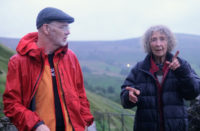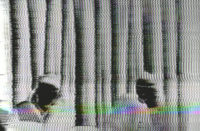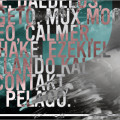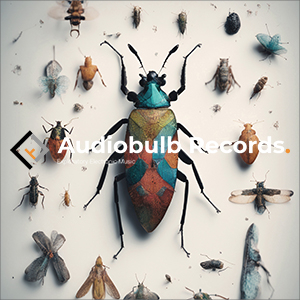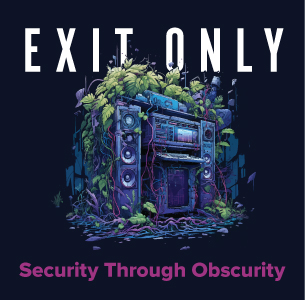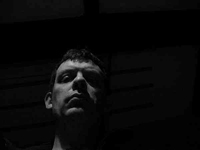
(November 2009) WITH so much music riding the waves right now, it remains an almost impossible task to explore each and every new birth. Releases are springing up all over the Internet, alongside those that contribute to the steady flow coming through the small independent labels. Of course such flooding of the market means that competition has never been fiercer; that said, every so often, it’s a welcome surprise to stumble upon something that strikes as quite spectacular.
“I started recording stuff to make the hairs on the back of my neck stand up (every boy needs a hobby). I used to be a member of the rather brill Electromancer music hosting website which unfortunately folded a few years ago. I miss it still – nothing beats getting feedback on ya tunes!” Phil Marsh.
Flip Martian is a U.K based musician/composer, aka Phil Marsh. The name Flip Martian, born out of a nickname, came about many years ago – courtesy of an old friend apparently, and clearly it was a name that stuck. Taking into account the small collection of intriguing compositions witnessed so far, it’s a pseudonym that fits remarkably well. Phil Marsh’s interest in the Electronic genre takes him back to the tender age of sixteen. He would later go on to play in a Gary Numan covers band, although in recent times he’s been working alone quite happily, with output that could easily have been scored to create vivid images of fantasy fiction; their arty, experimental and fluent structures emerging from an eclectic range of quality influence.
Initially it was a track entitled “Armageddon” which caught the attention of Igloo Magazine. This powerful work, which raises the bar in this genre significantly, is testament to what can be created when an ear and talent for such composition is manipulated to the full. It also takes opportunity in highlighting the quality of electronic music out there, hiding under rocks which all too often go unturned.
Interestingly, many moons ago, Flip Martian wrote an original track for a competition which was being run by Extreme Voice, the official fan club and website of ’80s synth masters Ultravox. The brief was to write an original track in the style and sound of Ultravox. The track, which was entitled “Rage in Vienna,” went on to win its category.
Playing further homage to Ultravox, the latest track from Flip Martian, “Ocean Road,” provides sturdy tarmac, with the recently re-worked version, Phil tells us, adding more of a rock element to the piece. “I threw in lots of Ultravox type sounds – the drumming style, synth solos, the rhythm guitar, synth bass and had a lot of fun reworking what was a far more electronic piece into something a bit more rocky.“
Overall you can expect from Flip Martian, an intelligent fusion of musical landscapes, inhabited by its very own futuristic appeal.
Igloo :: So how did it all come about?
Flip Martian :: A million and one years ago I took to creating music in my bedroom (*ahem*). Slightly less than a million years ago I helped form what became the first Gary Numan covers band in an age before Bjorn Again, when covers bands weren’t fashionable. We went our separate ways after a couple of years and since then, I’ve spent musical time creating music for myself and occasionally collaborating with others when it felt right. If it generates hairs coming up on the back of my neck, it gets finished, simple! I like loads, from Buddy Holly through to Simon and Garfunkel through to Gary Numan, Devo and Ultravox through to Marilyn Manson. What does my stuff sound like? “A racket,” some might say… Eighties synth stuff, sometimes Ennio Morricone Spaghetti Western music, Ultravox, you decide what else.
Igloo :: In general what is it that gets your creative juices flowing?
FM :: It varies – sometimes just walking down the road I’ll think of something in my head and spend a while humming, trying to keep it there if it sounds good! Other times, just doodling around on a synth – a particular sound I’m using can spark something. Or I can be at a gig, getting off on the live buzz and that might trigger off an idea.
Igloo :: The track “Ocean Road” is described by yourself as a soundtrack to driving down California’s Highway 1 – the coast road – how do set about creating such a piece? Is it from experience or do you create that imagery in your own mind?
FM :: Never been to America yet actually, so the imagery was just created in my head – although I’m sure film and TV helped a bit there. That particular track started off as a bass line and a melody – it was a rolling, driving kind of bass line and I thought it leant itself to driving music. It just developed from there into images of the California coast, a Corvette, wind in the hair… Not sure how, I think my brain just runs away with itself sometimes.
Igloo :: Just exactly how long have you been creating music? Aside your Gary Numan covers band, have you always had a preference to working alone?
FM :: I think I was about 16 or 17 and was really getting into electronic stuff at that age. I went out and bought a little Casio VL Tone (I remember it cost £36.95 from Dixons!) and I picked out Telstar on it. Eventually I started playing things into tape recorders. Nope, I only work alone when no-one wants to work with me! With the VL Tone, me and a mate used to mess about, with my mate on vocals and me on… er… VL Tone. Not too clever really! The only thing I remember from then was a cover of The Human League’s version of “You’ve Lost That Lovin’ Feeling” from their first album.
Later when I had a mono synth, a small Casio keyboard and a drum machine, me and another friend used to bounce tracks and overdub with cassette recorders – we did a version of Electricity by OMD which I still have somewhere on a tape. Then later I worked with a few guys in a band which fell apart quite quickly called both Grey Asylum and then Pink Asylum. I then worked with the singer from that for a few months in a band called The Render Control (I never did know what that meant…). We played a gig at a Numan disco in Redditch of all places in about 1985 I think it was. We weren’t really very good – he couldn’t really sing, for a start.
I was in the Numan covers band from late 1986 to about 1989 and then went back to working alone – I got married and didn’t have so much time for spending on music. I did a few tracks with a guy I knew in aqueer-core band and then later worked on a different Numan covers project called “Core” – lots of talk and buzz about that at one time but it ultimately died a death with not much being finished/released.
I was doing some stuff alone again (off and on) when some of the guys from the Numan covers band got in touch to talk about “doing it again before we’re too old.” That was early 2007 I suppose and that took up most of my musical energies until I quit earlier this year. Feedback to my solo stuff which I’ve been getting back into and re-promoting I suppose, has been generally positive, with a few people offering to work with me on stuff, all of which does spur you on a bit! All good stuff. So I’ve never been averse to working with others and always up for that. I do have strong ideas sometimes but if someone says “how about this?” and it sounds better… there’s no point in being closed minded, is there?
Igloo :: Armageddon is a very majestic track, and not at all typical in its arrangement or sounds – do you sometimes surprise yourself?
FM :: Yeah, someone suggested it was a bit prog rock, which was weird as I’ve never really listened to any of that… I don’t think it does but there ya go! I often have no set plan for how something will sound – sometimes I do, like with “Be Brave Young Soldier,” where I set out to do an Ennio Morricone spaghetti western type thing. More often though, a track is more organic and just grows into something of its own accord almost… one idea begets another idea… which then suggests something else, and so on.
Igloo :: Equipment wise what’s your current set up?

FM :: At the moment for recording its software synths mainly. I use Cubase and have done for many years (although that doesn’t mean I’m a master of it, by any stretch!). I also use CoolEdit to master and mix – it later got bought by Adobe and called Audition; essentially it’s a .wav editor. Hardware wise I have an Alesis Fusion which is a bit quirky but is a lovely sounding synth, a Korg MS 2000, Roland XP-30, Yamaha AN1x and an old 80s Roland synth called a JX 8P. I can’t justify all the hardware really now I’m not in the band and playing live, so some of the kit may get eBayed soon.
Igloo :: What are your views regarding the soft synth verses traditional hardware debate?
FM :: Lying down with a drink in my hand… Not really. Each has a purpose – for the way I work, soft synths are really convenient for recording, they’re easier to edit quite often too. But they are far less “physical” than hardware synths and for live use, give me hardware every time! I feel nothing watching people play soft synths on stage. I can see where the advantages are (cost, portability, emulating old sounds or whatever) but I think it’s a less emotional experience seeing someone playing a MIDI keyboard linked to a laptop.
Igloo :: What’s next for you – I know you’ve had some personal commitments recently, but will we see more tracks appearing soon?
FM :: Yes! Like I said earlier, some people have expressed a wish to work with me on some recordings which is very cool, so I hope that comes off. I want to get another few tracks finished and then look to putting an album together of stuff which works as a coherent collection of tracks. I plan on re-working 1 or 2 oldies from my back catalogue too and I hope to work with a couple of the guys from the Numan covers band on a track or two as well. Also, I was at a Brendan Benson gig a few weeks back and it made me really miss playing live. The Numan covers band didn’t do it anywhere near as often as we should have. So I’d love to try and get something organised where I can take my stuff out and play live in 2010. No idea how it might work but it would be cool to go out with a band and play again and actually play something with a bit of balls to it.
Igloo :: What’s this about you and old spaghetti westerns?
FM :: Well I’m not an aficionado or an expert by any stretch but I do like those old Morricone soundtracks which work really well with the visuals and have a few albums of that stuff. I was playing around with a trumpet sample one day, hit a particular note and thought “that sounds like a Morricone type sound.” And the whole track (Be Brave Young Soldier) developed from that into a kind of “soundtrack for a film in under 5 minutes.” Each part is fairly descriptive I think, if not very original! Essentially, a young soldier in the American Civil War, joining up, going off to battle, fighting, and getting killed. There are several parts of a similar style track which have been on my hard drive for quite a long time waiting to be melded together and finished so hopefully at some point, inspiration will strike and it will get finished.
Igloo :: You’ve took part in a couple of competitions now whereby you’ve had to produce music in the style of another artist – have you ever considered covering those artists and if so what would you cover and why?
FM :: Ultravox you mean? Well, a few years ago I was doing a version of “Sleepwalk,” which is probably my favourite track by them. Not a note for note copy, I’m rubbish at those – this was done a bit differently – and, accidentally, it got deleted! I was more than a bit miffed and couldn’t face redoing it, so that was that! Other than that, I would go with something by the John Foxx-led Ultravox or Visage possibly. But again, something rearranged – I can’t do note for note copies.
Igloo :: I definitely agree a Visage cover would work well. Some of your work is quite ‘soundtrack’ in style – is producing soundtrack something your interested in at all?
FM :: Yes, definitely. No idea how my stuff ends up that way but several people have said the instrumental stuff is very “visual.” A friend of mine offered to send some of my tracks to a friend working in T.V. in Germany, which was very cool – I just need to get some stuff put together onto a CD to send it over.
At a Glance – Flip Martian’s Work ::
“Armageddon” launches with a throbbing pulse, supplemented by a droid like voice-over, pushing its ultimate release. What comes into vision is a colourful alien landscape, drenched in volcanic clusters of shimmering synth swirls, scattered with enticing lonely bleeps and suggestive chimes. An instrumental which travels extensively in its quest to seek, its form takes on much digression, but for all its excursions through the deeply wooded areas of electronic mind pieces – it never loses the point, cleverly combining some thrilling chapters into its seven-minute mission.
Midway, there’s a break out into a quarter that captures an eerie moment of meandering, its rich resonance enhancing the inquisitive vibe throughout this calmer and more atmospheric section. The timbre of the synths lean towards early Visage, in particular tracks like “Moon over Moscow” and “The Steps.” Familiar chimes return to bring the pace back up as it draws to a conclusion. Armageddon is a superbly arranged science-fictional thriller of extraterrestrial activity.
“Ocean Road” heads out in the direction of calm with the subtle sounds of seagulls opening the track, however don’t be misled – this journey consists of nail biting night speeds. Bathed in a blur of neon light, it has an energetic synth led power-up, and the fuel to go miles. A distinct melody drives the track, giving it a fluorescent vibrancy combined with a racy edge, concluding it to be an anthem that’s incredibly power crazy.
Synth buzzes introduce catchy melodic sequences of intense depth, enhanced with the unmistakable sounds of a corvette motoring along. There’s some superb interaction and contrast – delivering an element of surprise, and leaving it largely un-typical. There’s a momentary slowing of tempo before it races on into more creative territory with yet more layered up synth textures, all engineered to feed depth of thought. Energy is dispersed alongside a fast moving sidewalk, grounded with a steady dance like pulse – an electronic trailblazer, which quite rightly, flies the flag of its own grandeur.
“Rage in Vienna” is simple in comparison to other works featured here. Its opening ‘tink tink’ will sound more than familiar to some, and as the bass line progresses into effortless melodic hooks, it drops a hint to Depeche Mode.
Slightly more disciplined, displaying strong foundations, it makes its mark in all the right places, its bright presence is happy to oblige during the pursuit for robotic grooves and unexpected blips of energy. Expanding surfaces of electronic synth pulses aid its voyage while touching slightly on the likes of Ultravox’s “Outlook,” although not as percussive. “Rage in Vienna” remains a candid synth victory over just another electronic excursion.
We look forward to reviewing the completed release in Igloo, however, in the meantime for more information on Flip Marians music and upcoming releases, visit myspace.com/flipmartian or email him here.







